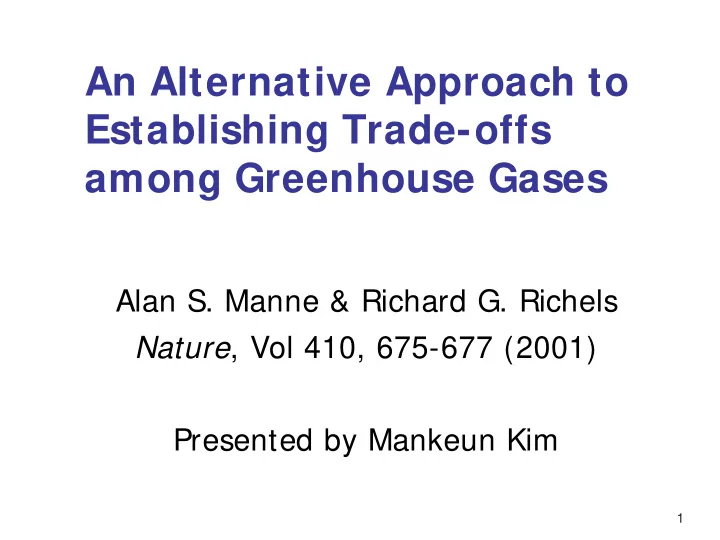

An Alternative Approach to Establishing Trade-offs among Greenhouse Gases Alan S. Manne & Richard G. Richels Nature , Vol 410, 675-677 (2001) Presented by Mankeun Kim 1
Outline ! Global Warming ! Greenhouse gases ! Kyoto Protocol ! Global Warming Potentials ! Shortcomings of GWPs ! An Alternative approach based on CGE 2
Global Warming ! Earth’s climate is determined by complex interactions between the sun, ocean, atmosphere, land and living things. ! The composition of the atmosphere is important because certain gases absorb heat radiated from the Earth’s surface ( Greenhouse effect ). 3
! Changes in the composition of the atmosphere alter the intensity of the greenhouse effect ! Human activities alter the balance. ! Raising concentrations of greenhouse gases are intensifying Earth’s natural greenhouse effect. 4
! As a results, the world is becoming warmer . ! The global mean surface temperature has increased by over 1 o F (0.6 o C) during the 20 th century. 5
Impacts of Global Warming ! Increased warming ! Drought and flash floods ! Vulnerable ecosystem ! Water supply ! Secure food supply ! Sea-level rise ! And so on… 6
Greenhouse Gases ! Naturally occurring greenhouse gases include water vapor, carbon dioxide (CO 2 ) , methane (CH 4 ) , nitrous oxide (N 2 O) , and ozone (O 3 ). ! Human activities add additional quantities of these gases, thereby changing their global average atmospheric concentrations. 7
Causes of Greenhouse Gases ! CO 2 ! Combustion of fossil fuels, solid waste & wood ! CH 4 ! Production/transportation of coal, natural gas or oil, ! Decomposition of organic waste in landfills, ! Raising of livestock and rice ! N 2 O ! Fertilization, legume, and manure industry activities ! Combustion of fossil fuels and waste. 8
Kyoto Protocol ! In 1997, the first international agreement to LI MI T EMI SSI ONS was established in Kyoto , Japan. ! Solving GHG emission problem implies reducing net emissions of GHG and stabilizing atmospheric concentrations at acceptable level. 9
Global Warming Potential ! GHG differ in their ability to absorb heat in the atmosphere. ! CH 4 traps over 21 times more heat than CO 2 ! N 2 O absorbs 310 times more heat than CO 2 ! HFCs and PFCs are the most heat absorbent. 10
! GWP is the physical measure established to compare emission equivalence of other gases to CO 2 . ! GWP is a quantified measure of the globally averaged relative radiative forcing impacts of a particular greenhouse gas through a set of time horizons (see Table 1). 11
Table 1. GWPs Global Warming Potential (years) 20 100 500 CO 2 1 1 1 CH 4 56 21 6.5 N 2 O 280 310 170 12
Shortcomings of GWPs ! The arbitrary choice of time horizon for calculating cumulative radiative forcing. ! The failure to incorporate damages and abatement costs . ! GWPs assume that the trade-off ratios remain constant over time . 13
! GWPs assume that they are independent of the ultimate goal . ! Clearly, neither of these assumptions makes economic sense. 14
Ideal Index ! The outcome of an analysis that minimizes the discounted present value of damages and mitigation costs . ! The alternative proposed extends beyond purely physical considerations in calculating trade-offs among gases 15
MERGE ! The analysis is based on a CGE model called MERGE. ! A M odel for E valuating the R egional and G lobal E ffects of GHG Reduction Policies ! Model structure and specification will be discussed in the class. 16
! The CGE model calculate the price of the various greenhouse gases . ! These prices express how much one should be willing to pay to emit an additional ton of each gas. ! The trade-offs are then relative prices of each gas . 17
Scenarios (Shock to CGE) ! The goal of climate policy is to limit the future increase in mean global temperature. ! Using MERGE, they identify an economically efficient strategy for staying within the limit (or ceiling) 18
! There are two scenarios ! Temperature ceiling 2 o C and 3 o C in absolute temperature change. ! Additional restriction – Decadal temperature change is limited within 10% 19
20 The Prices of CH 4 and N 2 O relative to that of CO 2
Recommend
More recommend